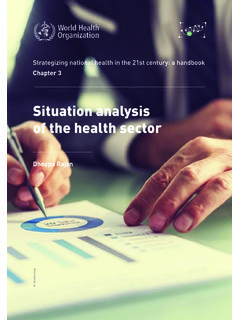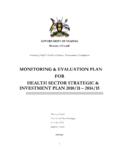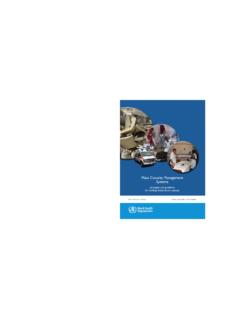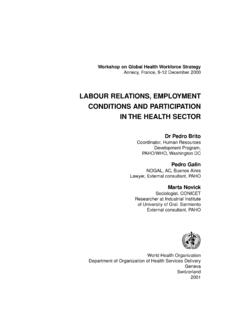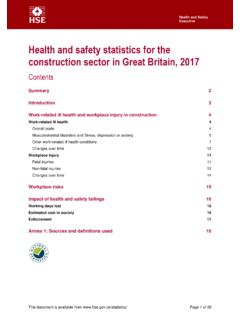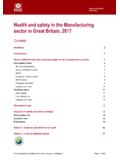Transcription of IMPLICATIONS OF HEALTH SECTOR REFORMS IN …
1 IMPLICATIONS OF HEALTH SECTOR REFORMS IN tanzania : policies , INDICATORS AND accessibility TO HEALTH SERVICESBy: Prof. Phares Mujinja and Dr. Tausi M. Kida2014 The Economic and Social Research Foundation (ESRF) THDR 2014: Background Paper No. 8 ESRF Discussion Paper THDR 2014: Background Paper No. 8, ESRF Discussion Paper 62 | iIMPLICATIONS OF HEALTH SECTOR REFORMS IN tanzania : policies , INDICATORS AND accessibility TO HEALTH SERVICESByProf. Phares Mujinja and Dr. Tausi M. Kida THDR 2014: Background Paper No. 8 ESRF Discussion Paper 62 ISBN: 978-9987-610-97-6@ 2014 Economic and Social Research FoundationEmail: Website: by:ii | THDR 2014: Background Paper No.
2 8, ESRF Discussion Paper 62 List of Tables ..iiiList of Figures ..iiiAcknowledgement ..iv1. Introduction ..1 Objective of the Study ..3 Scope of the Research ..3 Methodology ..3 Limitations ..42. Analysis of HEALTH SECTOR REFORMS Implementation and Supply Side Policy Interventions in tanzania ..5 The Context of the HEALTH SECTOR REFORMS in tanzania ..5 Public Private Partnership (PPP) in tanzania ..8 Human Resources for HEALTH (HRH) ..10 Regulatory Framework in HEALTH Care in tanzania ..143. Development of Main HEALTH Status Indicators during the HEALTH REFORMS Implementation ..18 Child HEALTH .
3 19 Maternal HEALTH ..21 HIV and AIDS ..22 Malaria ..244. The Demand Side Analysis: The Reflection of HEALTH SECTOR REFORMS on accessibility Services ..26 Introduction ..26 Affordability ..27 Appropriateness, Quality and Quantity of HEALTH Services ..29 Availability of HEALTH Services ..30 Acceptability of HEALTH Conclusions ..37 References ..40 Table of Contents THDR 2014: Background Paper No. 8, ESRF Discussion Paper 62 | iiiTable 1: HEALTH SECTOR REFORMS : Summary of major developments in the HEALTH SECTOR ..6 Table 2: HSSP III Targets and Indicators ..17 List of TablesFigure 1: Human resources for HEALTH gap at all levels, in tanzania as of 2006.
4 11 Figure 2: HEALTH Workers Per 10,000 Population by Region ..13 Figure 3: HIV prevalence 15-49, by wealth quintile, THMIS ..23 Figure 4: Contributions (in billions) to the national medicine and commodity requirements for tanzania from three sources ..31 Figure 5: Estimated funding gap for selected HEALTH commodities for 2012/13 ..32 Figure 6: Percent of facilities stocked out on the day of visit: essential medicines ..33 Figure 7: Comparison of amounts disbursed with amounts allocated to MSD for purchase and distribution of medicines and supplies ..34 List of Figuresiv | THDR 2014: Background Paper No. 8, ESRF Discussion Paper 62 AcknowledgementThis paper is published as part of the background papers for tanzania Human Development Report (THDR) 2014: Economic Transformation for Human Development in tanzania coordinated by the Economic and Social Research Foundation (ESRF).
5 Sincere gratitude is extended to Dr. Hoseana B. Lunogelo, the Executive Director of ESRF, for giving the opportunity to carry out the work. Special thanks are due to Dr. Tausi Kida, the Director of Programmes at ESRF and Project Manager for THDR for technical and coordination support provided throughout the process of preparation of the report. We would like to record our gratitude to members of THDR core team in charge of preparation of THDR 2014 for invaluable comments and guidance; these are: Prof. Marc Wuyts (ISS), Dr. Rodgers Dhliwayo (UNDP), Mr. Amon Manyama (UNDP), Dr Jehovaness Aikaeli (DoE UDSM), Dr. Kenneth Mdadila (DoE UDSM), Mr.
6 Ahmed Markbel (NBS). Mr. Sango Simba (NBS), Mr. Deogratias Mutalemwa (ESRF) and Ms. Monica Githaiga (UNESCO). We appreciate comments received from members of THDR working group and from different workshops held as part of the peer review process of the background papers of the THDR 2014. In particular, we thank Prof. Angwara Kiwara and Dr. Christopher Awinia for reviewing earlier versions of this paper. Last but not least, the authors would like to specially recognize the support extended by Mr. Danford Sango and Mr. Yasser Manu of ESRF at their capacity as members of THDR , ESRF would like to thank UNDP for financial support provided for executing the project.
7 THDR 2014: Background Paper No. 8, ESRF Discussion Paper 62 | 1 Immediately after independence, 1961, the Government aimed at building her human capital by isolating factors that were christened as major enemies of development : ignorance, diseases, and poverty. Disease as an enemy was fought by a massive increase in HEALTH facilities and low primary HEALTH care training institutions, most of them owned by the government. Alongside the public SECTOR existed the non-for-profit HEALTH facilities, mostly owned by Faith-based Organizations. tanzania went through a severe economic crisis in the 1980s, which adversely affected the management and financing of basic social services including HEALTH care services (Wangwe et al.)
8 1998). The HEALTH care SECTOR faced severe underfunding that affected the quality and provision of HEALTH care services. Underfunding of the HEALTH care delivery system at all levels led to, among others: shortage of drugs, equipment and medical supplies; overall deterioration of the physical HEALTH infrastructure including electricity supply, water and sanitation at the HEALTH care facilities; poor management and regulatory framework; and very low wages and other incentives for HEALTH care workers, which resulted in low staff morale. During this period, the Government was the key provider of free HEALTH care services whereas private HEALTH care provisions were nearly nonexistent except for a few faith-based HEALTH care facilities (COWI et al.
9 2007).In addressing these problems, the primary objective of the government since early-1990s has been to address the problem of severe underfunding and a weak management system by implementing HEALTH SECTOR REFORMS (HSRs), thus improving provision and access to HEALTH care services. As part of these ongoing REFORMS , in 1991, the importance of the private SECTOR in HEALTH care delivery was recognized where an amendment to the Private Hospitals (Regulatory) Act, 1977 was done, resulting into the establishment of the Private Hospitals (Regulation) (Amendment) Act, 1991. Following this act, qualified medical practitioners and dentists could manage private HEALTH facilities, with the approval of the Ministry of HEALTH .
10 Consequently, the HEALTH SECTOR was appraised to assess its performance and find strategies that would be employed to improve its functioning. Improvement of access to HEALTH services requires good HEALTH system with implementable policies that address equity values, social justice and the right to HEALTH and HEALTH information. The appraisal therefore recommended Proposals for HEALTH REFORMS , Ministry of HEALTH , 1994 (HSR) . The document suggested the REFORMS to be carried in the following dimensions: managerial REFORMS or decentralization of HEALTH services; financial REFORMS (such as introduction of user-charges in public facilities, introduction of HEALTH insurance and community HEALTH funds); public/private mix REFORMS (such as encouragement of private SECTOR to complement public HEALTH services); organizational REFORMS (integration of vertical HEALTH programmes into the general HEALTH services).







